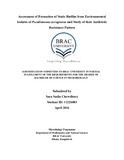Assessment of formation of static biofilm from environmental isolates of pseudomonas aeruginosa and study of their antibiotic resistance pattern

View/Open
Date
2016-04Publisher
BRAC UniversityAuthor
Chowdhury, Sara SadiaMetadata
Show full item recordAbstract
Biofilms are dense bacterial colonies networked within a polysaccharide matrix with a distinct
architecture that has the attachment potential to both living and inanimate surfaces.
Pseudomonas aeruginosa is a model biofilm forming microorganism which is associated with
nosocomial infections, urinary tract infections, medical device infections, middle ear infections,
cystic fibrosis, wounds and many more illnesses that causes the patients to reside in the hospital
for an extended period of time, elevating the morbidity and mortality rate. Moreover,
Pseudomonas aeruginosa originating from a biofilm is more resistant to a wide range of
antibiotics than the planktonic bacteria. Thus, this study determined and compared the biofilm
production potential and antimicrobial resistance of Pseudomonas aeruginosa isolated from
environmental biofilms, and a clinical strain of the same species that did not derive from biofilm.
Both types of strains were subjected to 15 different antibiotics to monitor their antibiotic
resistance against these anibiotics. It was observed that the Pseudomonas aeruginosa
environmental isolates were resistant to a wide variety of provided antibiotics, while, clinical
strain was comparatively resistant to only few of them. Furthermore, these antibiotic resistant
environmental stains and clinical stains were checked for biofilm formation by 96-well
microtitter plate biofilm assay. The results portrayed that the environmental strains potentially
formed a considerable amount of biofilm in the period of one week whereas; clinical stains
formed a negligible amount of biofilm. Antibiotic resistances of the same strains were examined
by the disc diffusion method for reconfirmation. Finally, the results reapproved that there is a
considerable dissimilarity in antibiotics resistance pattern of biofilm producers and non-biofilm
producing Pseudomonas aeruginosa isolates. Besides, it is tormenting that such numerous
antibiotic resistant Pseudomonas aeruginosa strains, which are responsible for detrimental
diseases are so abundant in the environment in the form of biofilms.
